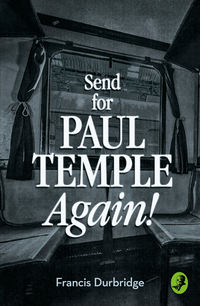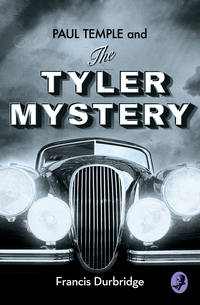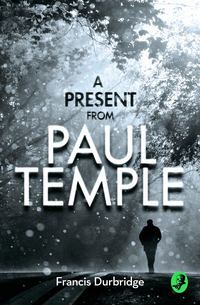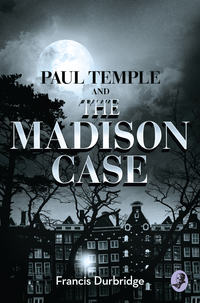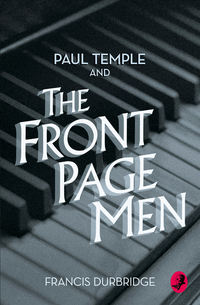
Полная версия
Back Room Girl: By the author of Paul Temple

FRANCIS DURBRIDGE
Back Room Girl
PLUS
Light-Fingers
AND
A Present from Paul Temple
WITH AN INTRODUCTION BY MELVYN BARNES

Copyright

an imprint of HarperCollinsPublishers Ltd
1 London Bridge Street
London SE1 9GF
www.harpercollins.co.uk
First published in Great Britain by John Long 1950
‘Light-Fingers’ and ‘A Present from Paul Temple’
first published in the Daily Mail Annual for Boys and Girls
by Associated Newspapers 1950, 1951
Copyright © Francis Durbridge 1950, 1951
Introduction © Melvyn Barnes 2018
Cover layout design © HarperCollinsPublishers Ltd 2018
Francis Durbridge asserts the moral right to be identified as the author of this work.
A catalogue copy of this book is available from the British Library.
This novel is entirely a work of fiction. The names, characters and incidents portrayed in it are the work of the author’s imagination. Any resemblance to actual persons, living or dead, events or localities is entirely coincidental.
All rights reserved under International and Pan-American Copyright Conventions. By payment of the required fees, you have been granted the non-exclusive, non-transferable right to access and read the text of this e-book on screen. No part of this text may be reproduced, transmitted, down-loaded, decompiled, reverse engineered, or stored in or introduced into any information storage and retrieval system, in any form or by any means, whether electronic or mechanical, now known or hereinafter invented, without the express written permission of HarperCollins.
Source ISBN: 9780008242039
Ebook Edition © February 2018 ISBN: 9780008242022
Version: 2018-01-09
Table of Contents
Cover
Title Page
Copyright
Introduction
Chapter I: Strange Visitors
Chapter II: Discovery of no Man’s Cove
Chapter III: A Man’s Life
Chapter IV: Rude Awakening
Chapter V: Chief Inspector Leyland Explains
Chapter VI: Bait for a Trap
Chapter VII: Atomic Secrets
Chapter VIII: A Shot in the Dark
Chapter IX: Smugglers and Monks
Chapter X: The Man With the Handcart
Chapter XI: Attempted Murder
Chapter XII: Strange Behaviour at the Inn
Chapter XIII: Midnight Rendezvous
Chapter XIV: Coffee for Three
Chapter XV: The Man in the Combe
Chapter XVI: Charlie Gets a Shock
Chapter XVII: Two Casualties
Chapter XVIII: The Old Priory
Chapter XIX: Ordeal by Torture
Chapter XX: This Way Out
Chapter XXI: Council of War
Chapter XXII: The Bolt-Hole
Chapter XXIII: Through the Tunnel
Chapter XXIV: Trapped Again
Chapter XXV: No Exit?
Chapter XXVI: Curtain for Delouris
Light-Fingers
A Present From Paul Temple
Solution to: Light-Fingers
By the Same Author
About the Author
Also in This Series
About the Publisher
Introduction
When Back Room Girl was published in July 1950, Francis Durbridge (1912–1998) had long been the most popular writer of mystery thrillers for BBC radio and was soon to become a ‘brand name’ on television and in the theatre. In 1938 the BBC had broadcast his serial Send for Paul Temple, and the novelist-detective and his wife Steve cemented their cult status in the sequels Paul Temple and the Front Page Men (1938), News of Paul Temple (1939), Paul Temple Intervenes (1942), Send for Paul Temple Again (1945) and many more. These first five radio serials were all novelised, published by John Long between 1938 and 1948, and most recently reissued in 2015 by Collins Crime Club.
Back Room Girl, however, was markedly different. It was Durbridge’s first book not to feature the Temples, and neither was it based on a radio serial. Instead it was an original one-off novel, which by the end of Durbridge’s writing career still compared only with The Pig-Tail Murder (1969) in this respect, although he had penned several standalone Sunday newspaper serials in the 1950s.
The Temple mysteries had invariably seen the sophisticated couple pursuing and unmasking murderers, so they all had a ‘whodunit?’ element. Back Room Girl, on the other hand, was not a detective mystery but an adventure/espionage thriller concerning skulduggery in a rural English setting. From the somewhat whimsical opening sentence, ‘It was early on the highly appropriate day of Friday that Roy Benton first saw the footprints in the sand,’ it must have been immediately obvious to any Paul Temple fan that this was not going to be typical Durbridge fare.
The year is 1947, and Fleet Street crime reporter and SAS hero Major Roy Benton begins a new life by retiring to No Man’s Cove in Cornwall to write his memoirs. He anticipates peace and quiet, but this seems increasingly unlikely when he discovers that a disused tin mine has become a research laboratory for a top secret project. He finds that the brilliant scientist Karen Silvers is heading the operation, and that his friend Chief Inspector Wilfred Leyland has been seconded from Scotland Yard because a sinister organisation is intent on stealing the plans.
The ringleader is Fabian Delouris, and he and his henchmen are Nazis (‘the worst Gestapo types’) who use extreme forms of torture to extract the information they require. ‘I have been,’ says Delouris, ‘a dealer in mass murder and the means to it for more years than I care to remember.’ This could account for the fact that Back Room Girl has not been translated and in particular has never been published in Germany, where Durbridge is otherwise a great favourite and where almost all of his novels have appeared.
The book has some themes that remain relevant today. For example, it speculates about the morality of Karen’s work on developing a weapon of mass destruction. ‘A curious way of preventing war,’ comments Roy, ‘to have a bigger stick than the other fellow, but … it’s the best we can do until we learn more sense’; whereas Karen believes that ‘This thing is so deadly, so devastating, that its very existence ought to prevent anyone ever going to war again.’ Underlying the story is also an element of surprise that a woman has been put in such a powerful position, although feisty Karen has always believed that ‘men had been merely people with whom she had to work because there weren’t enough women scientists.’
Back Room Girl therefore showed Durbridge in a new and unusual light, and he followed it up with two more novels that appeared to continue his move away from Paul Temple. But this was illusory, as Beware of Johnny Washington (April 1951) was a re-write of his first novel Send for Paul Temple, with some plot changes and a new set of characters without Paul and Steve, while Design for Murder (November 1951) was a novelisation of his 1946 radio serial Paul Temple and the Gregory Affair, but again with new characters instead of the Temples. (Both books, originally published by John Long and out of print for over sixty-five years, have now finally also been reissued.)
A key factor in Durbridge’s success as an entertainer, however, was his astuteness in recognising what his audience wanted. For the rest of his career as a novelist, apart from his standalone The Pig-Tail Murder, he concentrated on two reliable publishing categories. The first was the Paul Temple mysteries, which resumed in 1957 until 1988, of which five were based on his radio serials and three were original novels: The Tyler Mystery (1957), Paul Temple and the Harkdale Robbery and Paul Temple and the Kelby Affair (both 1970). The second category was adaptations of his phenomenally popular television serials, sixteen of which he novelised between 1958 and 1982. There were also two further instances of nifty recycling when Durbridge turned the radio serials Paul Temple and the Gilbert Case and Paul Temple and the Jonathan Mystery into the non-Temple novels Another Woman’s Shoes (1965) and Dead to the World (1967).
It transpired that Durbridge never again wrote a novel that resembled Back Room Girl in any way. Truly a one-off, it is a book that few among his legion of fans will have had the opportunity to read until now. The bonus short stories ‘Light-Fingers’ and ‘A Present from Paul Temple’ at the back of this book will be similarly unfamiliar to the modern audience. They appeared in consecutive editions of the Daily Mail Annual for Boys and Girls in 1950 and 1951, shortly after the publication of Back Room Girl, and show the lighter side of Francis Durbridge writing for younger followers of his radio series.
MELVYN BARNES May 2017
CHAPTER I
Strange Visitors
It was early on the highly appropriate day of Friday that Roy Benton first saw the footprints in the sand. The surprise of it brought him up dead. Again, appropriately enough, the first thought that came into his mind as he stood staring down at them was that he was probably feeling now as Alexander Selkirk felt when he first looked on human footprints in the sands of Juan Fernandez.
But, Roy reminded himself, as he continued to stare and Angus, his Cairn terrier, sniffed excitedly up and down, this wasn’t an inaccessible desert island hundreds of years ago – it was a Cornish cove in the year 1947 and anyone had a right to come there. True, it was called No Man’s Cove, and since he had first made his home there four months ago in the disused tea chalet he had not seen anyone, or even traces of anyone, nearer the beach than the road, which roughly followed the line of the coast at the head of the wooded valley a quarter of a mile inland.
That was why the footprints were such a surprise, and why Roy’s second reaction was one of annoyance and resentment that anyone had dared to invade the privacy he had enjoyed there. His third reaction was to glance round apprehensively to see if there was anyone in sight, for he was not wearing any clothes, so sure had he become that no one would disturb him. He was relieved when he did not see anyone. It wasn’t his cove, he reminded himself, as his eyes traced out once more the line of the footprints and Angus looked up curiously, as if asking what he was going to do about it, but he was realizing now that during the past months the absence of any other human beings had led him to think of this cove as a little domain of his own upon which, as time passed, and no one, not even an occasional tripper, came near, he had come subconsciously to feel no one would ever intrude. It was absurd, of course, and now these footprints had pricked the bubble of his little world as a sharp finger-nail punctures a balloon at a Christmas party. At the moment Roy was feeling an acute sense of deflation.
The footprints appeared to come out of the sea and curved away to his left, where, as he followed them, they gradually petered out as the sand gave way to coarse grass and then to turf. Roy wondered why he had not seen them when he went for the early bathe he had enjoyed every morning since he had come to the cove. Then he remembered that, instead of running down the beach into the sea as he usually did, he had gone a little way along the point to the natural rock diving platform which jutted out into deep water. It was only when he had waded out of the sea on his way back to the chalet and had seen Angus – who wouldn’t do more than wet his paws – running frenziedly up and down like a bloodhound on the trail, that he had discovered what all the fuss was about.
When had they been made, then? They could not have been there when he had walked down to the beach, smoking a last cigarette, at eleven o’clock the night before, or he would almost certainly have seen them, for there was a bright moon, and if he had missed them Angus would undoubtedly have drawn his attention to them. He had been out for his bathe by 6.30 a.m., so the prints must have been made during the night, or very early that morning.
He bent and examined them more closely. They had been made, he judged, by several pairs of boots, probably sea boots, and it was impossible, except perhaps for an expert tracker, to say how many pairs of feet there had been, though Roy would have hazarded several. They were deep prints, he noticed, especially the heels, and as the sand here was never very soft even when the tide had just uncovered it, that probably meant – he harked back to his scouting and, more recently, his Special Air Service days – that the wearers were carrying heavy loads.
Roy walked down to the sea’s edge, Angus hanging cautiously behind a little, looking for signs of a boat, or boats. There were two indentations a few yards apart which might have been made by a keel dragged up out of the water, possibly during an unloading operation, but the tide had washed over them and he could not be sure. But why on earth, he asked himself, should anyone want to unload anything at this isolated spot? There could not be any point in fishermen landing their catches here when there was a perfectly good harbour at Torcombe, the nearest village five miles up the coast.
Smugglers? Well, there had been plenty of them here in the old days, and it was, of course, possible that their modern counterparts were active now, for lots of Black Market stuff from the Continent was being got past the Customs somehow. No Man’s Cove would certainly be a good place for that sort of thing, but if some of the Torcombe men were involved – and from what he had seen of them Roy thought it unlikely – they would be running the risk of his seeing them, and he had not noticed anything suspicious. It was generally known in the village, to which he went for his supplies once a week, that he was living in the old chalet, and his presence there had at first caused a good deal of talk, though they seemed to have accepted him now. No, Roy felt that neither fishermen nor smugglers supplied a completely satisfactory solution to the mystery, though he saw that if he ruled out both these possible explanations the problem became even more puzzling.
He followed the footprints back up the beach, Angus trotting jauntily after him. Their course, he noted again, was not straight up the beach, which would have taken the people who made them direct to the chalet, but to the right and slightly inland, though he could not think of any place in that direction to which men carrying heavy loads (assuming that he was right and they were so burdened) could be going. The nearest village in that direction was Torcombe and the going was pretty rough. He and Angus had explored the immediate coast pretty thoroughly during their wanderings together, and at the moment he could not think of any place between the cove and the village which would supply the answer he was seeking.
Roy whistled Angus, who, tired of watching his master mooning around, had wandered off on a private and more enthralling expedition of his own, and turned to go back to the chalet for a delayed breakfast, but he stopped again as his eyes fell on marks in the sand he had not noticed before. They – by Jove, yes! – they looked very much like the imprints of the heel of a woman’s shoe, a broad one; a walking shoe, perhaps. Now how the devil … Roy walked back again alongside the prints to see if there were any more of them, but although there were one or two similar indentations they were blurred by the tracks of the sea boots and were not as clear as the first he had seen near the grass.
‘This is getting really interesting,’ Roy said aloud to himself, a habit he had acquired since he had been living alone, hearing the sound of human voices only when he went to the village, or the Cliff Top Inn on the coast road. ‘A woman and sea-fishing sounds a bit unlikely; but smuggling … that would attract plenty of women.’ His mind began to play about with all kinds of interesting possibilities. ‘Now don’t go jumping to conclusions,’ he told himself. ‘You’re not a Fleet Street crime reporter now, and there aren’t any glamorous women Secret Service agents at large any more outside books. If you’re going to finish those confounded war memoirs of yours, you’ve got to work like blazes, without starting up any crazy hares about smugglers. Stick to real life, my boy …’
But he couldn’t get those neat feminine footprints out of his head. What on earth would bring a woman to No Man’s Cove? One woman and two or three men? Landing from the sea … They must have had some definite purpose … it wasn’t just a pleasure trip.
Ideas churned through his mind in quick succession, and he realized that he would do little work that day until he had found out more about the mysterious footprints.
‘What about a nice walk after breakfast, just to clear the brain, old son?’ he asked Angus, skipping along beside him. The terrier barked eagerly as he recognized the familiar word.
‘Right you are, then,’ nodded Roy. ‘But breakfast first. The most languorous female spy in christendom isn’t going to spoil my appetite.’
Angus barked his approval.
CHAPTER II
Discovery of No Man’s Cove
As he followed the dog, Roy found himself tingling with an anticipatory excitement he had not known since his Fleet Street days. He had been getting a little tired of crime reporting even before the war came along, so that when he joined up it was not the wrench he had thought it might be. Still, it was a fascinating job; it had something which ‘got’ you, and the old spell was on him again.
He had been lucky in the Army – if you could call it lucky to be one of the last off the Dunkirk beaches, parachute into enemy-occupied territory and fight with the underground forces. Any way, he’d come through some pretty tight corners without a scratch and collected a DSO and Bar and an MC on the way, though none of his newspaper colleagues, when he saw them during his rare leaves, could ever get him to talk about his experiences. Damn it all, was Roy’s attitude, there were some things a man should keep between himself and his God – if he had one. Roy wasn’t sure whether he had or not, but all the same he had kept his war-time experiences to himself hitherto. It was only during the past few months that he had felt an overwhelming urge to put them on paper.
He paused to help Angus extricate himself from a rabbit hole and they went on towards the chalet. They had all been glad to see him back in the Daily Tribune office, and having had his fill of physical excitement for the time being, he had returned quite happily to his old job, though it had taken him some time to pick up the threads again. There were several new faces in the office and in the police force with whom he had to deal, and the number of new rackets that had sprung up in the wake of rationing and other controls was unbelievable. Investigating them had kept him pretty busy, but after a time their meanness and pettiness had begun to pall on him and he had become restless and discontented.
‘What you need,’ Bill Darkis, one of the Home Office pathologists Roy had met while working on a poisoning case, had told him, ‘is six months’ vegetating in the country. Why don’t you rent a cottage in Devon or Cornwall and write your war experiences? Do you good to get ’em out of your system. But don’t spend all your time indoors writing and smoking cigarettes. Get out and walk or dig. Do something with your hands instead of that thing of yours you call a brain.’
Roy had laughed and said he would think about it. He had done more. The summer before this he’d used his holiday trying to locate a suitable cottage. Again acting on Bill’s advice, he had bought a bicycle and gone riding along the south-west coast, or over the moors, just as the fancy had taken him.
He had been nearing the end of the fortnight’s trip when he had found himself in Shingleton, where he stayed the night. He had set out next morning for Torcombe along the cliff road. It had been a lovely day and he had dismounted to rest and enjoy a cigarette at the head of the combe, or valley, which led down to what he saw from his map was No Man’s Cove. Through the trees from where he had leaned against the wall that ran along the seaward side of the road he could see an inviting stretch of sand, and as there was no one in sight, he had decided to slip down for a quick bathe, leaving his cycle behind some bushes on the roadside.
Going down the combe, he had been surprised to come across the chalet, which had not been visible from the road because of the trees that flanked each side of a pretty little stream which ran down the bed of the valley to the sea. After his bathe he had gone to look at it more closely. A quick glance round showed that, apart from needing a coat of paint, a few new window-panes and some other minor repairs, the place seemed sound in wind and limb, so to speak. Indeed, it looked to be the very place he was seeking; remote, prettily situated, just the spot apparently if one didn’t want to be bothered by people. (It looks as if you’ve been bothered now all right, Roy reflected a little grimly.) In one of the windows there had been a faded, dirty notice:
TO LET – CHEAP

Appy Barwell & Co.
Caterers
Harbour Road, Shingleton
So back to Shingleton he had immediately gone to call on Barwell and Co. He vaguely remembered the name, and they had turned out to be the firm whose tea-shops and cafés he had seen dotted about the coast roads and villages like a rash, with their ‘Beautiful Barwell Teas’ signs. Ugh! Still, he’d been grateful for a cup more than once.
He recalled the breezy smart-Alec of a manager, who had told him that the chalet had been a great disappointment to them. If it hadn’t been for the war, of course … The manager had shrugged. They’d opened it in the summer of 1939, and at first hadn’t done too badly, considering all the war scares, but after that season it had been hopeless. Then the evacuation from the south-east had begun and for a time Shingleton Rural District Council had installed a couple of families from London there, but successive visitors had found that the loneliness and quiet of the place had got on their nerves more than the fear of the Luftwaffe’s bombs and they had drifted back to London. Since then the chalet had been empty. The evacuees had made rather a mess of the place, but if Mr Benton was interested they could soon have it cleaned up for him and made habitable.




